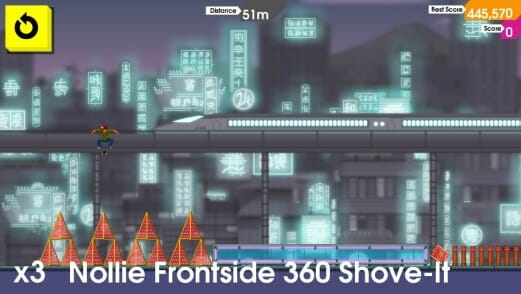OlliOlli (Vita)

My friend Alden was a skater. His knees were always scabbed up and bruised, his elbows bloodied, and even though that made him look really awesome, like a fifth-grade stuntman, I knew I could never seriously get into skating. I am not a fan of pain.
Games exist in part to let us get into things we’d never seriously get into. They make fantasies semi-real. Skating is a pretty mundane fantasy—again, this is a thing fifth graders do—but pain is real and frightening and games can eliminate that fear. I can’t last five seconds on a board, but I can watch The Search For Animal Chin or play Tony Hawk’s Pro Skater for an entire weekend. More than any other type of game, more than any sports sim or wrestling basher, skating games offer a virtual recreation of a real-life activity I wish I partook in but never will.
OlliOlli is a skateboarding game. It is a very good skateboarding game. But it shouldn’t be viewed in the same light as a Tony Hawk or Skate. The Vita exclusive from Roll7 owes more to a variety of flash-fire mobile games, from the Ur-endless runner of Canabalt to the high score hijinks and level-specific goalposts of every other mobile game in existence. OlliOlli is a basically a skateboard-themed mobile game that gives your left thumb a thorough workout.
Like a mobile game, OlliOlli is streamlined and clean-cut. You rush towards the right without pause, reeling off flip tricks on your board and stringing them together with increasingly ornate grinds. It’s not a legitimate endless runner—you can stop, and when you do the game ends—but the sensation is not too far from Canabalt or Jetpack Joyride. The major difference is that you have to keep that forward motion by pulling off those tricks with your left thumb.
As you jump with your board underneath you will quickly flick the left thumb stick to complete those vital tricks. You will jab it left, right or down and rotate it in various degrees of a circle like a fighting game. Instead of throwing fireballs like a street fighter (or Jerry “The King” Lawler) those arcs trigger a variety of flips. You have to press a button within a fraction of a second when you land to complete the trick perfectly and attain the maximum points. And since points are the end goal, both in OlliOlli and in life itself, you’ll want to land as many perfectos as possible.
Eventually the game prioritizes combos by introducing grinds. There’s another split-second window to land a grind perfectly, which you do by leaning the thumb stick in any direction as you coast down towards the rail. This gives you a bit of a speed boost, which, again, is crucial to scoring points and maintaining your forward motion. Every trick you link together increases your score multiplier, and if you chain flips to grinds to flips to perfect landings your final score for that sequence will increase exponentially. By the final stage you’ll be grinding almost exclusively, forced to nail rapid fire transitions between tricks and grinds just to stay alive and meet the minimum points requirement for each level.
